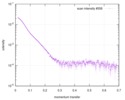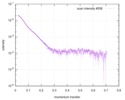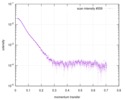+Search query
-Structure paper
| Title | Segmental, Domain-Selective Perdeuteration and Small-Angle Neutron Scattering for Structural Analysis of Multi-Domain Proteins. |
|---|---|
| Journal, issue, pages | Angew Chem Int Ed Engl, Vol. 56, Issue 32, Page 9322-9325, Year 2017 |
| Publish date | Aug 1, 2017 |
 Authors Authors | Miriam Sonntag / Pravin Kumar Ankush Jagtap / Bernd Simon / Marie-Sousai Appavou / Arie Geerlof / Ralf Stehle / Frank Gabel / Janosch Hennig / Michael Sattler /   |
| PubMed Abstract | Multi-domain proteins play critical roles in fine-tuning essential processes in cellular signaling and gene regulation. Typically, multiple globular domains that are connected by flexible linkers ...Multi-domain proteins play critical roles in fine-tuning essential processes in cellular signaling and gene regulation. Typically, multiple globular domains that are connected by flexible linkers undergo dynamic rearrangements upon binding to protein, DNA or RNA ligands. RNA binding proteins (RBPs) represent an important class of multi-domain proteins, which regulate gene expression by recognizing linear or structured RNA sequence motifs. Here, we employ segmental perdeuteration of the three RNA recognition motif (RRM) domains in the RBP TIA-1 using Sortase A mediated protein ligation. We show that domain-selective perdeuteration combined with contrast-matched small-angle neutron scattering (SANS), SAXS and computational modeling provides valuable information to precisely define relative domain arrangements. The approach is generally applicable to study conformational arrangements of individual domains in multi-domain proteins and changes induced by ligand binding. |
 External links External links |  Angew Chem Int Ed Engl / Angew Chem Int Ed Engl /  PubMed:28636238 PubMed:28636238 |
| Methods | SAS (X-ray in house) / NMR (solution) / X-ray diffraction |
| Resolution | 2.97 Å |
| Structure data |  SASDCC3: Nucleolysin TIA-1 isoform p40 in complex with U15 RNA  SASDCD3: Nucleolysin TIA-1 isoform p40 (LPQTG containing construct for sortase mediated protein ligation)  SASDCE3: Nucleolysin TIA-1 isoform p40 in complex with U15 RNA (LPQTG containing construct for sortase mediated protein ligation)  SASDCF3: Nucleolysin TIA-1 isoform p40 (TIA-1 wild type)  SASDCG3: Nucleolysin TIA-1 isoform p40 (LPATG containing construct for sortase mediated protein ligation)  SASDCH3: Nucleolysin TIA-1 isoform p40 in complex with U15 RNA (LPATG containing construct for sortase mediated protein ligation)  PDB-5o2v:  PDB-5o3j: |
| Source |
|
 Keywords Keywords | RNA BINDING PROTEIN / RRM / TIA-1 |
 Movie
Movie Controller
Controller Structure viewers
Structure viewers About Yorodumi Papers
About Yorodumi Papers



 homo sapiens (human)
homo sapiens (human)